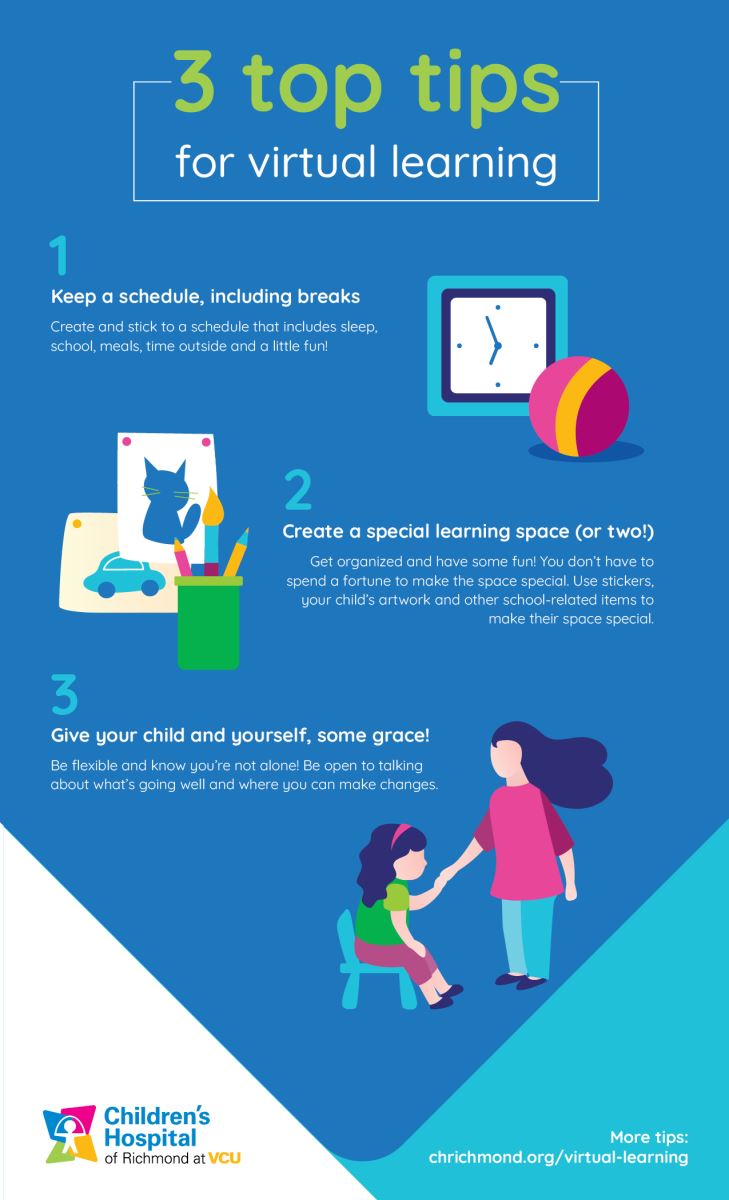
7 virtual learning tips to help parents prepare for a successful school year, even if it's online.
 Back-to-school this year will mean “back to their at-home learning space” for most kids and teens throughout Central Virginia, and many across the country as well. While students got some practice with distance learning in the spring, the new school year promises to be more structured and rigorous. The good news is most of us have had more time to plan, and we’re all in this together! There’s no one size fits all answer for virtual learning during a pandemic, but the following tips may prove helpful as you and your child prepare for the start of a new and different school year.
Back-to-school this year will mean “back to their at-home learning space” for most kids and teens throughout Central Virginia, and many across the country as well. While students got some practice with distance learning in the spring, the new school year promises to be more structured and rigorous. The good news is most of us have had more time to plan, and we’re all in this together! There’s no one size fits all answer for virtual learning during a pandemic, but the following tips may prove helpful as you and your child prepare for the start of a new and different school year.
“It’s a good idea to reflect on how things went at the end of last school year,” says Dr. Bergen Nelson, pediatrician, former elementary school teacher and mom of two. “What were the biggest challenges you faced as a family during the transition to learning from home? Are there things you can do differently to set everyone up for success this fall?”
Virtual learning: Tips for support and success
 1. Create a learning space
1. Create a learning space
This space doesn’t need to be large, fancy or equipped with brand new furniture. You can work with the space you have, focusing on making it conducive to learning. It should be quiet and clutter-free, with limited distractions – ideally separate from where your child plays or watches TV.
You can even convert part of the kitchen table to a work space, removing napkins, salt and pepper shakers, and other kitchen-related items. When the school day is over, pack up the supplies and use the table for a family dinner.
The most important thing is that your child has a designated space where they can shift to “school mode” and concentrate accordingly.
2. Get organized to help them stay focused
Many school systems have provided supply lists for virtual learning. Make sure you have these supplies gathered and organized in a way that your child can find them quickly when they’re needed. This will help them stay focused on the task at hand, rather than getting lost on a search for scissors or a sharpened pencil.
3. Keep a schedule, including breaks
If your child’s school has a specific schedule, be prepared to help them stick to it. If their virtual learning program is a bit more flexible, develop a schedule that works for your family and be consistent. The closer you can mimic a typical school day, the better. Kids thrive on routines and it will help to ensure you’re allocating plenty of time for each learning activity.
Make sure to incorporate physical and mental breaks into the daily schedule so everyone has an opportunity to refuel and refresh. Get a little exercise, listen to a favorite song or grab a healthy snack!
4. Practice logging into any virtual learning platforms
Get your child’s computer or other device set up and practice logging into any virtual learning platforms. Do they need to set up logins and passwords? Do they know how to get to the apps and websites they’ll need? Working through all of this in advance will allow your student to get comfortable and focus on learning. It will also give you an opportunity to reach out to your child’s school or specific teacher for help if needed.
5. Maintain open communication with your child's teacher
Speaking of reaching out to your child’s teacher, this is as important as ever. Introduce yourself and let them know you’re on their team and invested in your child’s success this school year. Since you’ll now have the front row seat to your child’s day-to-day learning, it will also be helpful for you to let the teacher know when your child is struggling or might need a little extra guidance. Develop a plan for how you will check in with the teacher and how frequently, finding the balance that works best for everyone.
If your child will need to miss class due to an illness or appointment, communicate this with the teacher so they can provide missed assignments and help ensure your child doesn’t fall behind.
6. Show interest, encourage independence while online learning
Though virtual learning may come with some challenges, it also provides a great opportunity for you to support your child while helping them develop independence. Help them get set up, review their schedule with them and encourage them to complete their work in a timely manner. Provide positive feedback when they’re doing well and constructive guidance when you see areas of opportunity.
During virtual learning, parents are also in a prime position to help children navigate barriers. Encourage your child to reach out to the teacher if they have questions or challenges. Solve problems together so they can build confidence to do it on their own in the future. This will look a little different depending on your child’s age and ability level, but an opportune time to set the groundwork nonetheless.
7. Give your child, and yourself, some grace
It’s normal for parents and kids to experience anxiety, frustration and other emotions as you navigate this new process of virtual learning. According to a Gallup Poll, 70% of families are using an online K-12 distance learning program from their school while others have opted for alternative methods, so it's important to remember that a lot of parents and guardians are facing challenges. Everyone may need to be a little flexible at first, but things will get easier as your family settles into your routine. Encourage your child and yourself and celebrate each victory…big or small! We look forward to still seeing your back to school photos and all of the milestones your child will reach this year as they continue to grow and learn in new ways.
